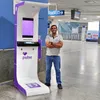COVID-19: How IoT tech is no longer a luxury, but a necessity
Smart homes, offices and hotels can help eliminate the need for touching surfaces like switches, dispensers and limit human contact, in turn helping to prevent the spread of diseases like COVID-19.

While the world continues to live under the cloud of uncertainties and fear arising because of the COVID-19 outbreak, its impact on everyone’s psychology and behaviour is unimaginable.
Simple, yet most effective, protective measures against the novel coronavirus such as social distancing and regular hand-washing, along with protecting us from the spread are also shifting our behaviours slowly. Everyone is trying to cut down contact with strangers or with items/exposed surfaces that are touched by several people to avoid the possibility of catching the infection.
There are few items such as switches and remote controls that everyone ends up touching multiple times in a day, even amid the health scare we are currently witnessing.
A technology that can help eliminate the need of touching such items is the Internet of Things (IoT). IoT can help prevent diseases like COVID-19 by eliminating the need to touch items to operate them in various scenarios, be it at home, a hotel, and offices.
Smart Home
There is a plethora of IoT devices such as smart video door phones, smart locks, smart lights, smart TVs, and smart air conditioners (ACs), among others, that can add a lot of convenience for smart home-use cases. These devices can be controlled touchless-ly by use of voice assistants such as Google Assistant, Alexa, and Siri or through your mobile phone.
For example, video door phones can help users to check visitors at their home. With two-way audio of the video door phone, users can interact with visitors through mobile apps and can totally eliminate undesired and less-important visitors. Particularly, it can be very useful when you are dealing with food and e-commerce deliveries.
Additionally, controlling lights, fans, ACs, and other home appliances is easily possible without touching the switches or using remotes. Users can also schedule on and off times of these appliances, further reducing the physical contact one has to make to switch on/off the appliance.
Smart Office
Major use cases of IoT in an office environment are Smart water and beverage dispensers, smart access controls, smart facility management that includes control of lighting and AC using IoT.
Smart dispensers can be controlled via gestures, mobile app and voice commands, leaving no room for any physical contact with common resources such as water dispensers and coffee machines.
Smart access controls that are non-biometric and are based on combination of RFID tokens or randomly tokens on mobile apps also enable employees at the workplace to get access to specific areas without having any need to touch any access control system, which are otherwise used by multiple employees each day.
Smart facility management not only helps reduce energy consumption, but also eliminates the need to control lighting and HVAC (heating, ventilation, and air conditioning) at workplaces through switches. Using a centralised cloud accessible dashboard, facility managers can set schedules, scenarios, and rules for controlling and setting appropriate modes for resources such as lights and HVAC.
Smart Hotel
Hospitality has been impacted the most by COVID-19. IoT can help the industry with zero contact check-ins, which are seamless and reduce the time spent by guests at the hotel’s lobby.
IoT tech is also capable of adding personalised experience in rooms for guests. They can interact with room services and the front desk using voice assistants placed in rooms. Flipping channels or movie catalogs on your voice operated smart TV, operating curtains in the room using voice commands, controlling room lights and setting desirable temperature/mode on ACs not only add to the guest’s experience but also provides a touchless experience.
IoT is becoming more of a necessity than luxury for homes, offices, and hotels. With social distancing in mind and to avoid multiple touch points, mobile apps and voice control is the way to go forward.
(Edited by Apoorva Puranik)
(Disclaimer: The views and opinions expressed in this article are those of the author and do not necessarily reflect the views of YourStory.)








